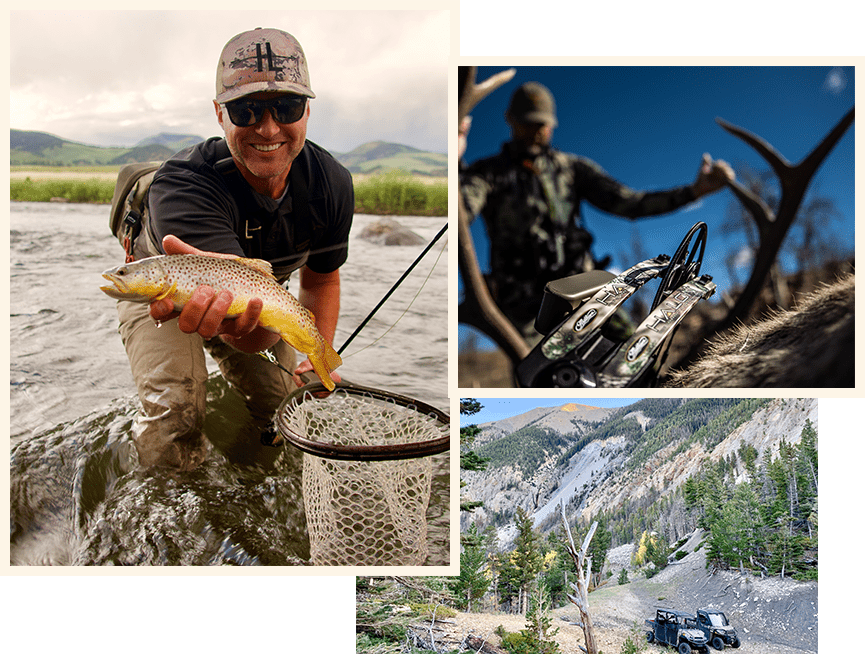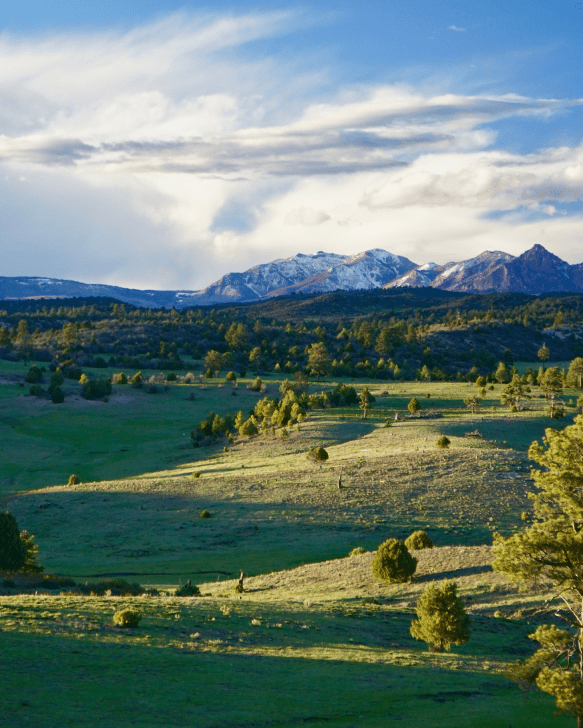If you are an investor or rancher owning a large Colorado ranch, here find reminders to help maximize your assets and benefit your property values. Care for facilities, improvements, equipment, soils and water, forests, and vegetation—and wildlife habitats.
Smart ranch managers on large Western ranches quickly catch on to the value of enhancing habitat for wildlife. Wildlife habitat on and around their properties can improve property values. This article addresses plans to get this done. It begins with ranch management.
Ranch Management
If you effectively manage your land, your property values will improve. Ranch management skills effect property values. For example, pastures may feed elk, or a stream could become a hatchery. Prices for leasing and outfitting may be higher, increasing your income. Conservationists certainly appreciate protected wetlands just as hunters head to public and private properties where choice wildlife roam. So, we find increased property values from the vantage of both conservation and recreation.
Ranchers Caring Proactively for Habitats
How do successful ranchers maintain wildlife habitat? They enact plans for wildlife management, habitat management, and then execute overall ranch management. These three aspects converge. Let’s dive into some proven initiatives that could help increase the value of your ranch investment portfolio.
We’ll also talk about how the Rocky Mountain Elk Foundation, one of many conservation organizations, approached challenges at Rocky Mountain National Park west of Denver. Finally, we’ll mention some of the possibilities for recreational ranches. Your ranch property may be well-suited for another income-producing recreational activity.
Wildlife Management Benefits
Over time, by managing your property to accommodate wildlife, you’ll reap long-term benefits. Plan practical improvements and take it step by step. (See a list of helpful programs later in this article.) Many ranchers annually take it one project at a time. They build on the previous year’s progress. Layers of benefits culminate in economic benefits and increased property values.
Putting your attention on wildlife management produces many benefits, including:
- Aesthetic benefits
- Recreational benefits
- Social benefits
- Educational benefits
- Ecological benefits
- Economic benefits
Emphasizing property values, let’s take a few moments to discuss the economic benefits of habitat management. Any size ranches—those near the cities and the Front Range, mountain ranches, farms in the High Plains. These landowners can maintain their wildlife habitat–for small birds to trophy elk– by shifting emphasis to the natural areas. This is a cost-effective approach.
Do you know that planting trees increases property values by thousands of dollars? Trees also effect habitat. For example, plant a shelter belt and you’ll effectively build habitat for wildlife. Plant rows of evergreens, deciduous trees, and shrubs and you’ll reduce wind and erosion while offering shade and catching drifting snow.
Wildlife favor the prairies and meadows. Ranchers save money by introducing drought tolerant native plants in sunny areas. It takes an initial expense and then lowers the cost of field maintenance over a five-year period. Ranchers can also plant pest-resistant native vegetation to increase habitat and reduce labor costs and upkeep.
Look for the educational aspects. If you plan to develop habitat on a Colorado ranch, think about how organizations, groups, and classes could use the property for educational purposes. Professors bring their students, scouts earn badges, and guides may show newbies how the hatch was enabled by your thoughtful wetlands.
Increasing values in the hospitality industry. As travelers become more aware of the need to preserve the natural environment, they seek lodging with environmental advocacy. It turns out that the wildlife friendly management approach can be financially rewarding by attracting these consumers.
Habitat Management
A wide range of wildlife live along the Rocky Mountains. Ranches for sale in low-lying areas of the High Plains feature birds and small animals. Deer move into higher elevations during the summer and then return to the lower elevations during colder weather. Bear, elk, and other large animals hover deep in the mountain habitats. Let’s see how we can attract birds and animals to our Rocky Mountain ranches.
Wildlife depend on native plants, trees, and waterways there. Although habitats very in biodiversity, elevation, geography, and resources, we will give an overview. Many practices enhance wildlife habitat and attract the animals, such as:
1. Remove non-native plants.
2. Plant native plants, shrubs, and trees.
3. Build brush piles.
4. Leaves snags or dead trees.
5. Create nesting areas.
6. Release/prune trees and shrubs for growth.
7. Fence out livestock.
8. Create riparian buffer to improve water quality.
9. Protect pools.
10. Improve forest edges.
11. Create herbaceous forest openings.
12. Plant forage and grassland.
13. Restore wetlands.
14. Protect seeps for freshwater to surface.
15. Connect two isolated habitats for a wildlife corridor.
To manage habitat, assume ranchers and investors want to welcome wildlife to their properties. The first place to start will be to control non-native and invasive plant species, including noxious weeds. These plants take over, reducing the amount of native plant species that the wildlife need. Wildlife use native plants for food, shelter, and reproduction.
Then plant permanent vegetation for wildlife. The vegetation needs to provide food and cover. Start with native trees, shrubs, grasses, and herbaceous plants. Some ranchers purposely build pollinator gardens, prairie gardens, and buffers near water.
This takes releasing, or pruning, and clearing brush to strengthen desired growth. We want the desired vegetation to receive necessary sunlight. By planting some fruit trees or nut-producing trees along with shrubs, we’ve added food sources. Evergreens provide nesting sites.
Because wildlife need places to take cover, they look for piles of brush near their feeding or nesting sites. Small animals, birds, deer, and elk all take cover in the brush. Place your brush piles close to forest openings, edges, and timbered areas. You’ll notice herds of elk often take cover at the edges of fields where the brush has grown up near an irrigation ditch, for example.
To build a brush pile, use large wood for foundation and work up to the smallest limbs. Another way to create a brush pile is to leave a variety of partially dead standing trees where birds, mammals, reptiles all converge. Some ranchers may deaden trees or leave a stand of beetle trees for this purpose.
Plans for Managing Land with Wildlife
Anyone interested in preserving habitat needs to look at habitat management plans. In northwest Colorado, Rocky Mountain National Park created their Elk & Vegetation Plan to address overpopulation and public access, the specific needs of the public park.
In this case of parkland, they looked inside the national park. However, the population of elk spent seven months outside the park during the winter. So, they had to look beyond. This park happens to be near residential communities. So, this park needed to address the situation on adjoining lands and in the park.
The purpose of their plan was 1) to reduce the impacts of elk on vegetation and 2) to restore the natural range of variability in the elk population and affected plant and animal communities. They surveyed the wildlife populations from the air and ground.
In the end, Rocky Mountain National Park needed to reduce the number of animals and provide viewing opportunities for the public. Phasing in their plans, they implemented fencing, vegetation restoration, culling, and elk redistribution. They also measure its effectiveness over time beginning in 2008 through 2028.
Another concern in the elk population has to do with controlling chronic wasting disease or CWD. The disease can spike if wildlife interact with domestic cattle.
Wildlife Habitat Programs
Several government and private programs compensate landowners who manage their properties by certain standards. Ranchers can also apply for grants for help with wildlife management and research. To participate, the landowners strive to take an environmentally sensitive approach to creating wildlife habitat and protect natural resources.
At times, adjoining landowners participate together in the programs to protect a larger and connected patch of wildlife habitat, providing even greater benefits to the biodiversity. Think wetlands, forested areas along streams, plant, and animal species.
Special programs may assist with mitigation actions like prescribed burning, forest thinning, noxious weed treatments, the establishment of wildlife water developments, and other projects to enhance elk and wildlife habitat.
Wildlife habitat programs for landowners also offer professional and monetary assistance. For example, you can find a program to help you realize a habitat-enhancement goal, design habitat plans, provide resources, or simply help ranchers get going.
Here are some popular initiatives:
1. Wildlife Habitat Incentives Program
2. Wetlands Reserve Program
3. Forest Stewardship Program
4. Forestry Incentives Program
5. Forest Legacy Program
6. Stewardship Incentives Program
7. Environmental Conservation Acreage Reserve Program
8. Environmental Quality Incentives Program
9. Conservation Reserve Program
As a good environmental steward, the landowner receives economic, educational, ecological, and social rewards. Another beneficial program has to do with conservation easements.
Conservation Easements
Over the past few decades, more ranch owners have been dedicating portions of their properties to conservation easements and public land access. Hikers and hunters, anglers, ATV drivers, and other members of the public have been asking for greater access. On a similar note, environmental organizations have been willing to pay landowners if they agree to refrain from developing portions of their ranches. This also helps protect wildlife habitat.
Tax relief is one of the major benefits of conservation easements. Every land conservation agreement is unique. When it comes to selling the rights to a portion of your ranch property in this way, your agreement will differ from every other agreement on the books.
For example, the RMEF agrees to permanently protect land for “quality elk range, migration corridors, and calving areas.” The organization also tries to open or improve quality public access opportunities. To these ends, RMEF and similar organizations have their eyes on land acquisitions and exchanges, conservation easements, contributions, and other transactions.
Add Value to Recreational Ranches
Recreation is a big world. When it comes to adding recreational activities to a ranch in Colorado or Montana, what do you think of? We know hunting and fishing make the list. Horseback riding and now four wheeler access make it incumbent upon sizable ranches to create back roads and trails. The trails also serve as wildlife corridors.
In addition, some ranches have been able to add recreational activities and lodging. Some of the more notable guest ranches are actual working ranches where guests participate in taking care of the ranch as a form of recreation. So, when it comes to adding to your ranch’s property values, you have many recreational options.
With a few simple improvements, you can enhance the flyfishing and lake fishing activities available on the ranch. If you have a lake, you could add a dock or put in ramp. If you have a fulltime, or seasonal creek, you can create pools of water, hatcheries, and
Ranch Brokers – Harrigan Land Company
Sit down with Harrigan Land Company to find out more about Colorado ranches for sale with wildlife habitat. Staffed without doors enthusiasts well-versed in the pros and cons, Harrigan Land will go the extra mile to find the ranch market to fit your investment goals. The Dave Harrigan and Hunter Harrigan and their entire team look forward to meeting you. Call us at 303-908-1101 today. Serving Colorado, New Mexico, Wyoming, Utah, and Montana.


